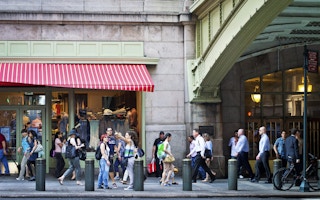Mumbai, India can be a commuter’s nightmare. Downtown sits a full 10 miles from the residential core, and the two areas are poorly linked by public transport. Mumbaikars have the longest commute of any Indian city resident, averaging more than 47 minutes each way every day. This fragmented urban development has pushed car ownership in the city to rise by an astonishing 3,700 per cent in the past 60 years, clogging roadways and polluting the air.
To continue reading, subscribe to Eco‑Business.
There's something for everyone. We offer a range of subscription plans.
- Access our stories and receive our Insights Weekly newsletter with the free EB Member plan.
- Unlock unlimited access to our content and archive with EB Circle.
- Publish your content with EB Premium.
Travel to New York City and the landscape is much different. A single city block houses a mix of restaurants, office buildings, residences, and shops. This type of development—known as “mixed-use development”—makes it easy to use public transport, walk, or bike, helping to efficiently connect the city’s neighborhoods through sustainable transport. The portion of commuters relying on cars in the city fell from 90 per cent to 59 per cent between 2010 and 2011.
These two cities showcase an emerging urban design lesson: Sprawling cities decrease quality of life; compact, mixed-use developments yield economic and social benefits.
Sprawling and Segregated: The Cost of Disconnected Cities
The proliferation of zoning at the beginning of the 20th century contributed to sprawling cities around the world. Residential neighborhoods sprouted on the urban periphery and in suburbs, giving rise to car-dependent commuter towns. City centers languished, shopping malls replaced commercial streets, and the urban poor were segregated from the wealthy elite.
“
Sprawling cities decrease quality of life; compact, mixed-use developments yield economic and social benefits.
These sprawling cities are increasingly common in developing nations. For example, Mexico’s history of dispersion created thousands of single-family houses on the outskirts of cities. The sheer distance to everyday destinations means some families spend 25 per cent of their income on transport. This type of design increased Mexico City’s greenhouse gas (GHG) emissions by up to 70 per cent and costs USD 2.5 billion (33 billion pesos) each year in lost economic productivity.
Connected Communities Improve Health, Environment, and Economies
Mixed-use development works against these trends to create inclusive, connected communities. In mixed-use areas, you can find housing, restaurants, services, schools, cultural facilities, parks, and more. This connectivity reduces the need for private vehicles, thus increasing the viability of public transport, walking, and bicycling. For example, Mexico City’s longest street, Avenida Insurgentes, is home to a range of services, residences, and businesses, but traffic congestion initially made the street difficult to access. For these reasons, local decision-makers chose Insurgentes as the site for the city’s first bus rapid transit (BRT) system, Metrobús. After the launch of Metrobús in 2005, 100,000 daily car trips were replaced by sustainable transport, easing congestion and reducing the city’s GHG emissions by hundreds of thousands of tons.
 Everyday needs should be close enough to residential neighborhoods that they can be reached by walking, bicycling, or public transport. Photo Credit: EMBARQ.
Everyday needs should be close enough to residential neighborhoods that they can be reached by walking, bicycling, or public transport. Photo Credit: EMBARQ.
By reducing the need for vehicle travel, mixed-use development also brings shared community space. Plazas, parks, and sidewalks foster interaction among community members—interaction that wouldn’t be safe or possible under a sprawled, car-centric design model. One landmark study of San Francisco compared three neighborhoods identical except for the levels of vehicle traffic on their streets. It revealed that residents of the neighborhood with the lowest level of car traffic had three times as many friends and twice as many acquaintances as their more heavily trafficked counterparts.
Finally, mixed-use, public transit-friendly neighborhoods benefit local economies. They save individuals money on transportation by reducing the length and number of everyday trips and eliminating the need for car ownership. Mixed-use development also supports local businesses by increasing foot traffic. Transport for London found that pedestrians spend up to 60 per cent more money at businesses each month than those traveling by car, while spending less on transportation. Combining mixed-use development with pedestrianization—or closing some areas to cars to promote more walking—reinforces these benefits.
Human-scale neighborhoods encourage different activities and social interaction, recreating the streets and sidewalks as viable public spaces. Photo Credit: EMBARQ
Growing Cities and Sustainable, Mixed-Use Development
According to the World Health Organization, cities will hold 70 per cent of the world’s population by 2050. About 96 per cent of this growth will occur in developing countries, demanding quality urban spaces and services.
As current cities expand and new ones crop up, it’s important for local leaders, urban planners, and citizens to examine what works. Compact, car-light cities spur economic growth, social cohesion, and quality of life.
Luis Zamorano is the Director of Urban Development and Accessibility for EMBARQ Mexico, and Erica Kulpa is a road safety analyst for EMBARQ Mexico. This post is part of a nine-part series on people-oriented cities and originally appeared on the World Resources Institute’s Insights blog.












